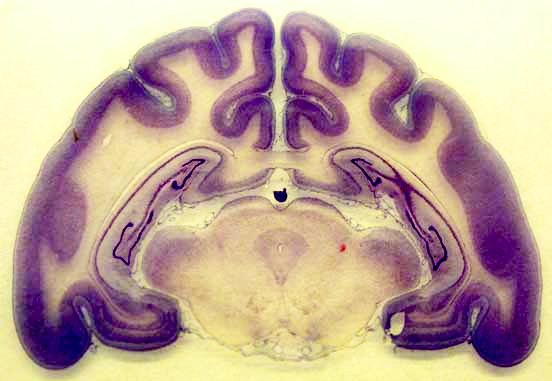Serendip is an independent site partnering with faculty at multiple colleges and universities around the world. Happy exploring!
The Cat Forebrain

Now we are looking at a coronal section of the forebrain of a cat.
As with the human and monkey forebrains, this image is a good illustration of the cerebral cortex at the frontal lobe of the brain. The dark purple that looks like an outline is gray matter. The light purple inside the dark purple is white matter. You can also see the body of the corpus callosum, which is the structure connecting the two hemispheres of the brain. The white elliptical openings within the brain are ventricles, which are fluid-filled cavities that serve to cushion and protect the brain.
Does this look different from what you saw in the human and monkey forebrains? What is similar? What is different? Compare this with the human forebrain. Or compare with the monkey forebrain. Do you notice any differences in amounts of neocortex? If you remember, the midsagittal views of the five brains showed a relative decrease in cortex. How much cortex do cats have in comparison to humans? How much cortex do cats have in comparison to monkeys? It seems that cats do, indeed, have less neocortex relative to their brain size. Also, they have much less gyrencephalization (i.e. less cortical folding). What does that mean in terms of their intelligence?
Where shall we go from here? Click on your browser's "back" button to return to the midsagittal view of the cat brain, or click on one of the buttons below to learn about these structures, to slice other brains, or to move on towards magnification.






Comments
Post new comment